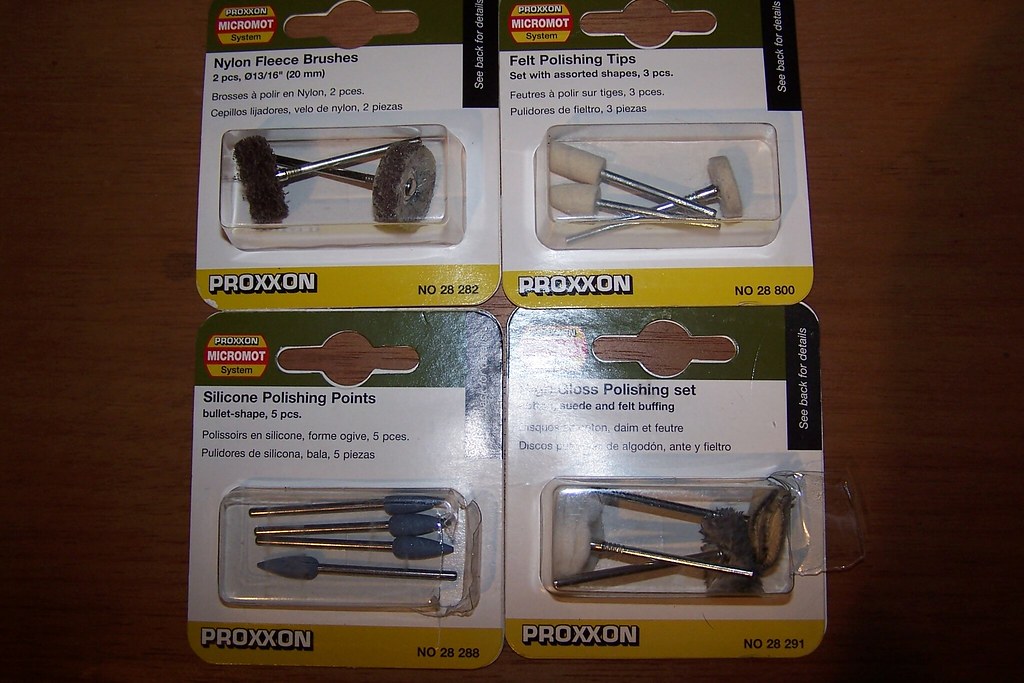Results 1 to 10 of 12
Thread: dremel help
-
05-07-2009, 10:35 AM #1
 dremel help
dremel help
So I finally got sick of handsanding and picked up a dremel.
Im practicing on a cracked rusted to crap junked blade, but I cant seem to get it to work.
Im using the sandpaper tube bit (I dont remember its proper name) but I cant get it flat enough for a good finish, i get these wavey lines where only the top of it hits the metal
any tips?
-
05-07-2009, 10:42 AM #2Beard growth challenged

- Join Date
- Feb 2009
- Location
- Berlin
- Posts
- 1,928
Thanked: 402
Get yourself the 22 mm sky blue silicone lens for Proxxon with aluminium oxide embedded.
They can sand and polish depending on pressure and ankle.
.. and they fit into a Dremel as well. I'm hardly using anything else since I discovered them.Last edited by 0livia; 05-07-2009 at 10:49 AM.
-
The Following User Says Thank You to 0livia For This Useful Post:
jakoblah (05-07-2009)
-
05-07-2009, 01:13 PM #3< Banned User >

- Join Date
- Apr 2008
- Location
- Newtown, CT
- Posts
- 2,153
Thanked: 586
I agree. The little drum sanders are great for flat surfaces but when you are dealing with compound curves the drum becomes difficult to use effectively. There are the silicone rubber tips, flapwheels, rubber backed disks, nylon fleece and other more forgiving abrasive tools for Dremel. I personally prefer the Proxxon selection. They are cheaper and I believe they carry a wider assortment. Here are a few I like to use:

Just a bit about safety. You said you are praticing on a cracked blade. This is dangerous practice. The cracks in a blade don't always end where you think they do. The stresses on a damaged blade are unpredictable and can cause a crack to propogate through the steel alot faster than you may be able to react. Once a blade is cracked it is dangerous to fiddle with using a power tool. At any time polishing a razor, wear eye protection If not a full face shield and a heavy apron. Pay careful attention to the rotation of the tool. Never let the bit spin onto an edge, always spin off the edge. It is best to somehow fixture the blade or at least brace it against a leather sandbag so the thin steel is supported from beneath. It is always alot more gratifying an experience that doesn't end up with a trip to the emergency room.
Brad
-
-
05-07-2009, 01:29 PM #4

thanks mate, ill try and hunt some of them out.
by cracked blade I mean its cracked from heel to spine and that piece has come off, so its a short blade now. Thanks for the tips though, the leather bag is a great idea.
-
05-07-2009, 02:28 PM #5

Most hardware stores in the states will sell flapwheels from 80 grit to 220 grit. Then there are the new polishing sanders that fit into the new rapid release mandrel. I think they end at 320 or 400. Then it is hand sand to 2500 or you can buy split mandrels and make your own flap wheel.
Felt wheels, turtle wax and then felt wheel.
Felt wheen, Maas and then felt wheel.
OOOO Shiney.
-
The Following User Says Thank You to singlewedge For This Useful Post:
mdunn (05-08-2009)
-
05-07-2009, 05:25 PM #6< Banned User >

- Join Date
- Feb 2009
- Location
- Phoenix
- Posts
- 1,125
Thanked: 156
Uneven wavyness is highly correlated to dremel sanding.
 All we can do is minimize it.
All we can do is minimize it.
-
05-08-2009, 03:20 AM #7
-
05-08-2009, 03:38 AM #8Senior Member

- Join Date
- Mar 2007
- Posts
- 608
Thanked: 124
The abrasive buffing wheels seem to work pretty well, also. You'd want to use them after a a flap wheel or something like that, they tone down scratches more than remove material.
-
05-08-2009, 02:44 PM #9

I have an old dremel that only goes to 15k rpm. So I can keep the pressure to a minimum and use light strokes, the flap wheels really create no noticeable pattern once the whole blade is done. You can see the pattern, but it is not as bad as hand sanding. I am working on a Bengall wedge now, and hope to have that done soon using only the above methods.
-
05-08-2009, 06:42 PM #10Senior Member

- Join Date
- Feb 2009
- Location
- Sacramento California
- Posts
- 102
Thanked: 7
Do not use the Dremel on that beaut of a double notched Elliot.

I'll have to fly down there and take it from you if you even think of it!


 LinkBack URL
LinkBack URL About LinkBacks
About LinkBacks






 Reply With Quote
Reply With Quote
